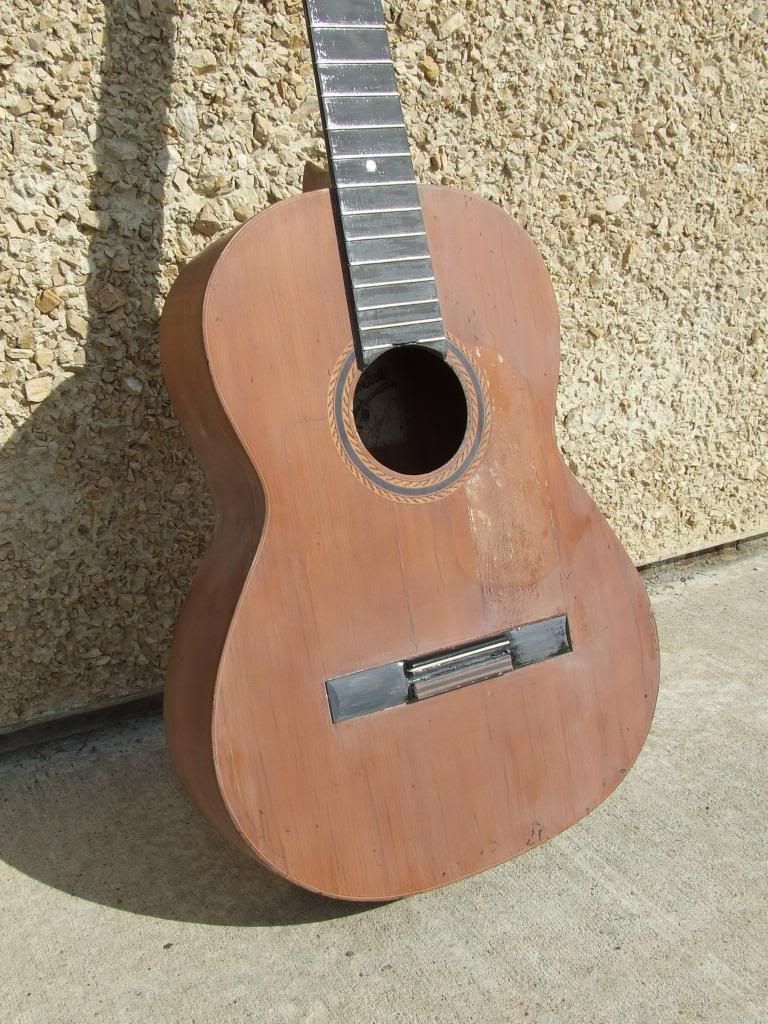
 |
|
#1
|
|||
|
|||
|
And so it begins. 1973 Evelio Dominguiez Flamenco project. Super cheap e-Bay score. Cypress back, sides and neck. Cedar top. Beautiful hand-carved fan bracing inside the body. All solid woods. Even the rossette inlay around the soundhole is made of tiny wooden pieces. Some IDIOT oversprayed the entire guitar (frets and all) with a thick coating of clear polyurethane, and installed a cheap plastic pickguard to the top. I'm in the process of hand-sanding the poly crap off, and revealing the original French Polish finish. It'll take some time, but it's definitely worth the effort. OLE!!!
 
Last edited by fogrider; 10-11-2013 at 11:04 AM. Reason: pics |
|
#2
|
|||
|
|||
|
Quote:
Last edited by arie; 09-06-2013 at 04:09 PM. |
|
#3
|
|||
|
|||
|
"Evelio" is coming along. The back, sides and neck are done. The top soundboard is ready for sanding and buffing. Frets will be going in tonight. After that I'll install 2 white tap-guards on either side of the soundhole, do some bridgework, and set up the string action. If it sounds as good as I think it will, I'll probably invest in some really nice brass tuners.
http://s929.photobucket.com/user/cra...25772493117921 Last edited by fogrider; 09-13-2013 at 11:01 AM. |
|
#4
|
|||
|
|||
|
looks nice! cypress?
|
|
#5
|
|||
|
|||
|
Hard to say for sure what the back and sides are made of. Traditionally, Cypress was used. It almost looks like mahogany, although I've seen Flamenco guitars made of Monterey Cypress that take on a striped appearance. The top looks very much like cedar. I'm unclear about the neck. It's definitely a different wood than the back and sides, much lighter in colour, with a tighter grain.
The neck has a traditional spanish heel, and the soundboard fan bracing is extremely thin and delicate. The upper kerfing is interesting in that it consists of thinly cut trangulated pieces, spaced about 1/2 inch apart all the way around the guitar. The vertical side braces are arched outwards at their tops. The lower kerfing is solid, and square in section. From what I can gather, Evelio Dominguez was a music instructor and instrument builder, who built some guitars for his students. This guitar is a "Class B" according to the sticker, which makes me think is is a student model. The shop still exists in Madrid, although I think Evelio has retired from the business. The wood is lovely, and has the look of a fine old piece of furniture. I managed to sand off the nasty overspray, and I've applied one very thin coat of Tru Oil to the body, hand sanded it to 2000 wet, buffed it with Meguiars Final Cutting Compound, and then hand rubbed the body with Swirl Remover. This guitar is giving me a chubby. 
|
|
#6
|
|||
|
|||
|
Quote:
The neck could be "Spanish Cedar"; the back looks like mahogany. |
|
#7
|
|||
|
|||
|
I agree with your assessment Charles, judging by the photos I've seen of Spanish Cedar grain patterns, it's traditional use in Flamenco necks, and the fact that E. Dominguez was Cuban born and was likely very familiar with this species of wood.
Spanish Cedar has a strong aroma. This guitar does indeed have a nice perfume smell to it when I sniff through the soundhole near the spanish heel block. I'm also leaning heavily towards Mahogany as the body wood. |
|
#8
|
|||
|
|||
|
Quote:
 some steel string builders use them as well. usually made from the same wood as the top but not always. i have a guitar in which i made what i call "falsollones". false tentellones made by gluing up reverse kerfing then sawing through the kerf and cleaning up the fuzz afterward. they look nice and even, but the clean-up took way too long. this builder is also using wedges to lock down the sides to the neck. torres was said to have used them as well. very cool. Last edited by arie; 09-13-2013 at 02:21 PM. |
|
#9
|
|||
|
|||
|
I have when building face-down with a Spanish heel construction - something I don't do anymore for steel strings.
Quote:
|
|
#10
|
|||
|
|||
|
the guitar is a size 2 with a cedar top and i wanted to get more monopole action from the smaller sized top without overly thinning everything else out.
|
|
#11
|
|||
|
|||
|
Quote:
And, did you get it? |
|
#12
|
|||
|
|||
|
not done yet.
|
|
#13
|
|||
|
|||
|
Nice project Fogrider, hope you enjoy the finished guitar and excuse me for side tracking a bit but am curious about what Arie has done.
Quote:
Jim |
|
#14
|
|||
|
|||
|
Quote:

|
|
#15
|
|||
|
|||
|
Thanks Arie, I understand what the monopole mode is. So by more "monopole action" I assume you mean a greater excursion of the top during the monopole mode of vibration. I understand how edge thinning is related to monopole mobility, I understand how brace shaping is related to it as well but what I am not sure about is the use of tentellones and how you have used them to improve mobility? or by what mechanism they will improve mobility?
Jim |
 |
|
| Tags |
| evelio dominguez, flamenco |
|
|